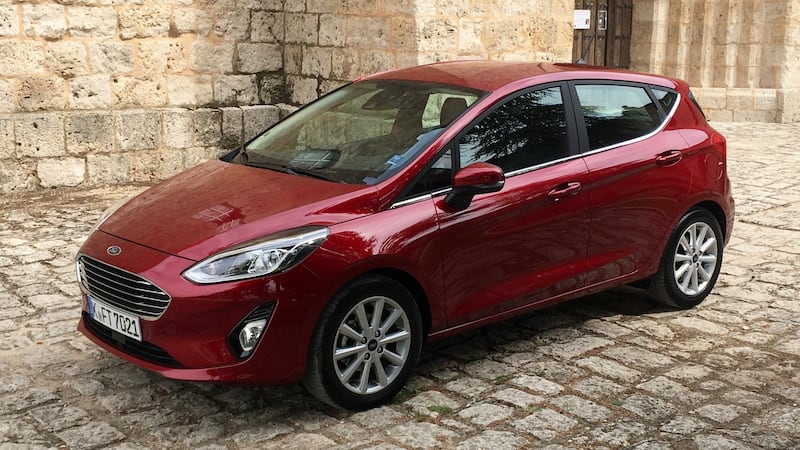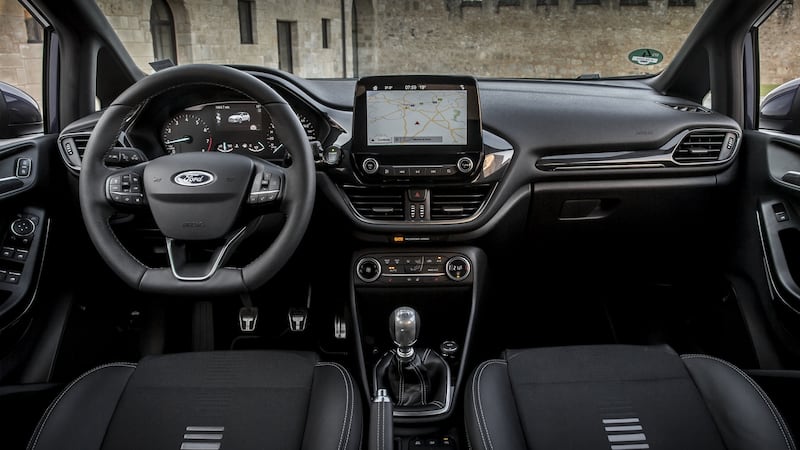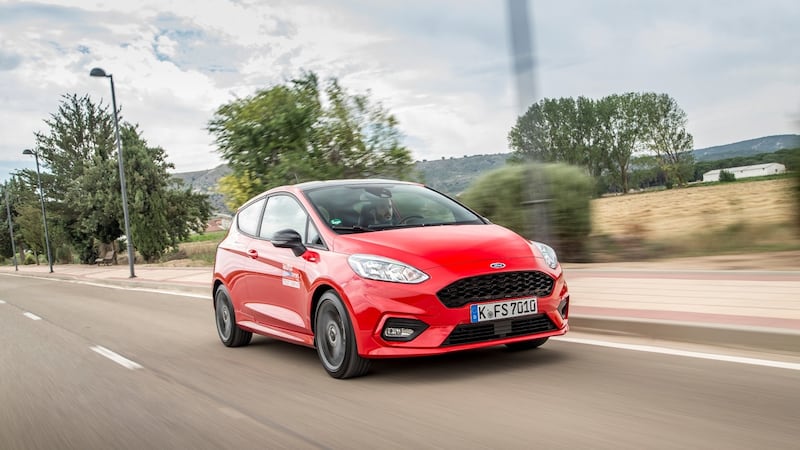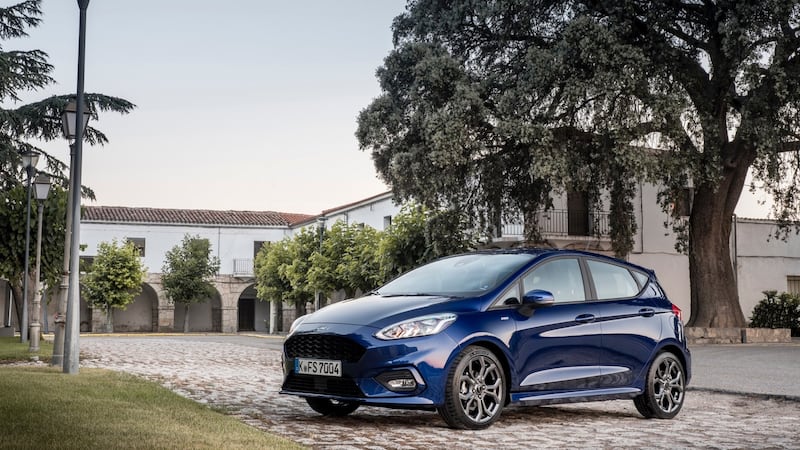Anniversaries in the car business happen all the time. Last year the Ford Fiesta celebrated its ruby anniversary with 40 successful years in the Irish market. The seventh generation of the front-wheel drive hatchback has just been launched, but unlike many fortysomething motorists, the Fiesta has bypassed a mid-life crisis.
With that in mind, the new car’s exterior is an evolution rather than revolution; in truth quite underwhelming compared to the outgoing car. Ford, every now and then, gives a model a radical makeover, but not so this time.

0 of 3
The distinctive wedge silhouette continues in this latest car, while the front nose bears a striking resemblance to previous generations of the Fiat Punto – not something you might say to a Ford designer within arm’s length. Overall there is nothing too radical about the styling and this will please conservative buyers.
However it does seem on first inspection that there is little to merit calling this a new generation Fiesta. Even the platform is carried over with just a few alterations. The chassis has been stiffened and the suspension revised, but that’s hardly something to write home about, so what is going on?
On closer scrutiny significant improvements have been made to the way the car goes and stops, and to the interior, which is now far less cluttered. Ford revealed the new Fiesta at its “Go further” event last year in Cologne where it said the car would be the most technologically advanced small car.
That’s an impressive boast for a new model, with prices starting at €16,550 for the three-door version and €17,150 for the five-door. Those prices are actually down by a few hundred euros on the run-out prices of the last model, which is a rare event in the motor trade.
Tech times
Depending on the specification you choose, the technology and driving aids available are impressive. Auto parking with brake intervention and a pedestrian protection auto braking system that even works at night, feature for the first time as part of 15 new assistance technologies. You cannot get all the safety systems in one safety pack as with some rivals, but the new features are available as part of several smaller competitively priced packs.
This is the first small car to make use of two cameras, three radars and 12 ultrasonic sensors, which in combination are able to monitor 360 degrees around the vehicle. Lane keeping alert/assistant is standard but other driving aids are a costly option. The €700 driver assistance pack should be on everyone’s list as it features distance alert and adaptive cruise control and pre-collision assistance (auto emergency braking).
The auto high beam option is €250 and fades the lights between high and dipped beam when meeting oncoming traffic without the driver having to move a finger. This pack also includes traffic sign alert, where the camera reads the road signs and shows it on the dash so the driver knows the speed limit in that particular area at all times. It also has driver alert, which monitors driver behaviour and can spot if fatigue is setting in.
The active auto park assistance pack is a €200 option that features front and rear parking sensors, advanced auto park assistance and a rear view camera. The new Fiesta can auto park in to parallel or perpendicular parking spaces once the space is the car’s body length plus 20 per cent. The system can also drive out of the space.
Exterior and Grades
Changes to metal are subtle but the new lights give the game away especially at the rear and these set the new car apart from the old. Horizontal tail lights replace the vertical clusters. The Fiesta gets a nose job with new grilles that define what grade the car is.

Ireland will see three trim levels available from launch, namely Zetec, Titanium (adding €1,200 to the price on a like-for-like basis) and the range topping Vignale (price to be confirmed). Other markets offer a lower entry grade, but Ireland isn’t taking this. Towards the end of the year an ST Line grade, that has sports suspension as standard will join the range. All our test cars were highly specified Titanium, ST Line and the range-topping but expensive Vignale models that featured most of the options list.
I took a Fiesta Vignale for a test drive, more out of curiosity than in-depth research. Apart from nice 18-inch alloys, a nice grille and good looking seats, it simply isn’t special enough and fails to deliver a luxurious small car experience.
Vignale flops
Ford’s Vignale luxury brand has been a flop in Ireland. The idea was to have highly equipped Ford models called Vignale that would be sold exclusively through Ford’s flagship dealerships called Ford Stores. With only three of these in Ireland, Ford has decided to allow all Vignales, starting with Fiesta, to be sold in all of its 52 dealerships nationwide.
When asked if this demonstrated that the Vignale strategy to create a premium sub-brand with a special elite dealer group has been a failure Ciarán McMahon, chairman and managing director of Ford Ireland pointed to the lack of scale in Ireland for such a bespoke strategy and said Vignale had been a success in European countries where on average each country would have 10-15 Ford stores. Dealers with Ford Stores in Ireland will continue to have exclusive rights to sell Mustangs and Focus RS models, however.
Engines largely carried over
The Fiesta engine range is predominantly petrol. Irish buyers get a modest engine choice starting with a three cylinder 1.1 litre. This is a reworking of the outgoing 65hp one litre non-turbo three cylinder engine.
It is available in two outputs: 70hp at €17,150, the expected best seller in the range in Ireland; and 85hp. A livelier one litre 100hp three cylinder Ecoboost is also available.
In the Zetec grade it is paired to an automatic gearbox but in Titanium you can have it in auto or six speed manual guise. The range of power units on sale is market-dependent and while Ford Ireland won’t stock the 125hp and 140hp petrol units or the new and relatively powerful 120hp 1.5 litre TDCi, customers can order them. The 1.5 TDCi pushes out 120hp and is a great cruiser with plenty of low end grunt. The other engine I drove was the Ecoboost 140hp.
On the road
The new 120hp diesel in Titanium trim proved to be a composed cruiser with great pulling power. There is very little engine noise in the cabin and it would be an ideal choice for a high-mileage commuter – if someone was prepared to do that in a Fiesta.

I was however blown away by the Fiesta ST Line with the 140bhp Ecoboost engine. I simply loved the handling its sports suspension delivered. With its 10mm lowered stance and stiffer set up the ST Line version is nippy and eager. It was wonderfully fluid behind the wheel and it put a smile on my face.
The Fiesta overall remains a great driver’s car and is now more agile than ever. The hushed cabin made cruising on twisty Spanish country roads a stress free joy. The Fiesta’s steering has been tuned for less friction and it now delivers a more premium feel. The gearing remains unchanged and the little Fiesta simply goes where it is pointed with enthusiasm. New electronic torque vectoring, ESC and ABS revisions, stronger brakes and better tyres when coupled with revisions to suspension bushings, shocks and springs make the Fiesta quite possibly the best handling car in its class.
Poverty spec
Sadly as with too many European car launches the poverty spec engines that Ireland’s price conscious buyers are going to be offered were not present. Even the Irish version of the Zetec trim grade, that does without Ford’s impressive new 8-inch floating dash mounted touchscreen, was unavailable to test, leaving me to ponder how underpowered the new Fiesta will feel unless buyers opt for the 140hp Ecoboost or 120hp diesel. Ford says that traditionally Fiesta buyers in Ireland are in their 40s or 50s, but with the new car it hopes to attract a younger audience.
Ford Ireland says its five-door, €17,150 70hp 1.1 Zetec will account for about 50 per cent of sales. The fuel split will be about 90 per cent petrol to 10 per cent 85hp diesel, while 60 per cent will be Zetec grade. It reckons the 100hp Ecoboost will account for about 5 per cent of the petrol range.
Ford says it used the impressive Volkswagen Polo as its benchmark. As tested, it matches the VW for comfort and offers better ride and driving dynamics. Yet the Polo still has the edge for interior space, especially in the rear, while it’s pricing is noticeably lower than the new Fiesta, starting at €15,370 for the base Trendline 5-door.
Nice touches
There are a few nice new touches with the new Fiesta. There are concealed edge protectors that pop out when you open the door. First seen on the Focus RS and later on the Skoda Kodiaq the €100 option can prevent paint damage and stop you giving other vehicles “car park kisses”.

The new B&O Play sound system, the first in a Ford, follows the trend of ordinary car makers who offer a premium sound option in partnership with a recognised hi-fi brand. The 675 watt, 10-speaker system has been tuned specifically to the supermini’s cabin and there is even a 360-degree surround sound stage option. The sound quality is great.
Still to come
In early- to mid-2018 the Fiesta Active crossover will join the range. This version features a slightly higher driving position and some faux soft roader styling bits and piece. Fast Ford enthusiasts will be happy to hear the 200hp Fiesta ST is on the way too, towards the end of next year.
The blue oval brand wants to push the Fiesta more upmarket as it also sells the value-for-money Ka+ in the same small-car sector. Ka+ is little threat to the Fiesta at the moment with 400 sales expected this year compared to Fiesta’s predicted 3,200. Next year Ford expects Ka+ sales to rise to 800 units.
Ford threw some nerdy facts at us such as its novel use of sound analyses in the manufacturing process. The optional leather seats are resistant to coffee spills and even dye staining from new denim jeans. My favourite new Fiesta statistic concerns Ford’s robot buttocks, yes a robot derriere simulated a human sitting in to the Fiesta 25,000 times to ensure the new seat’s durability.
The Fiesta is close to the benchmark Polo, but it doesn’t quite hit the spot as tested. And having enjoyed versions with sufficient power I’m not really looking forward to driving the low-powered versions.














